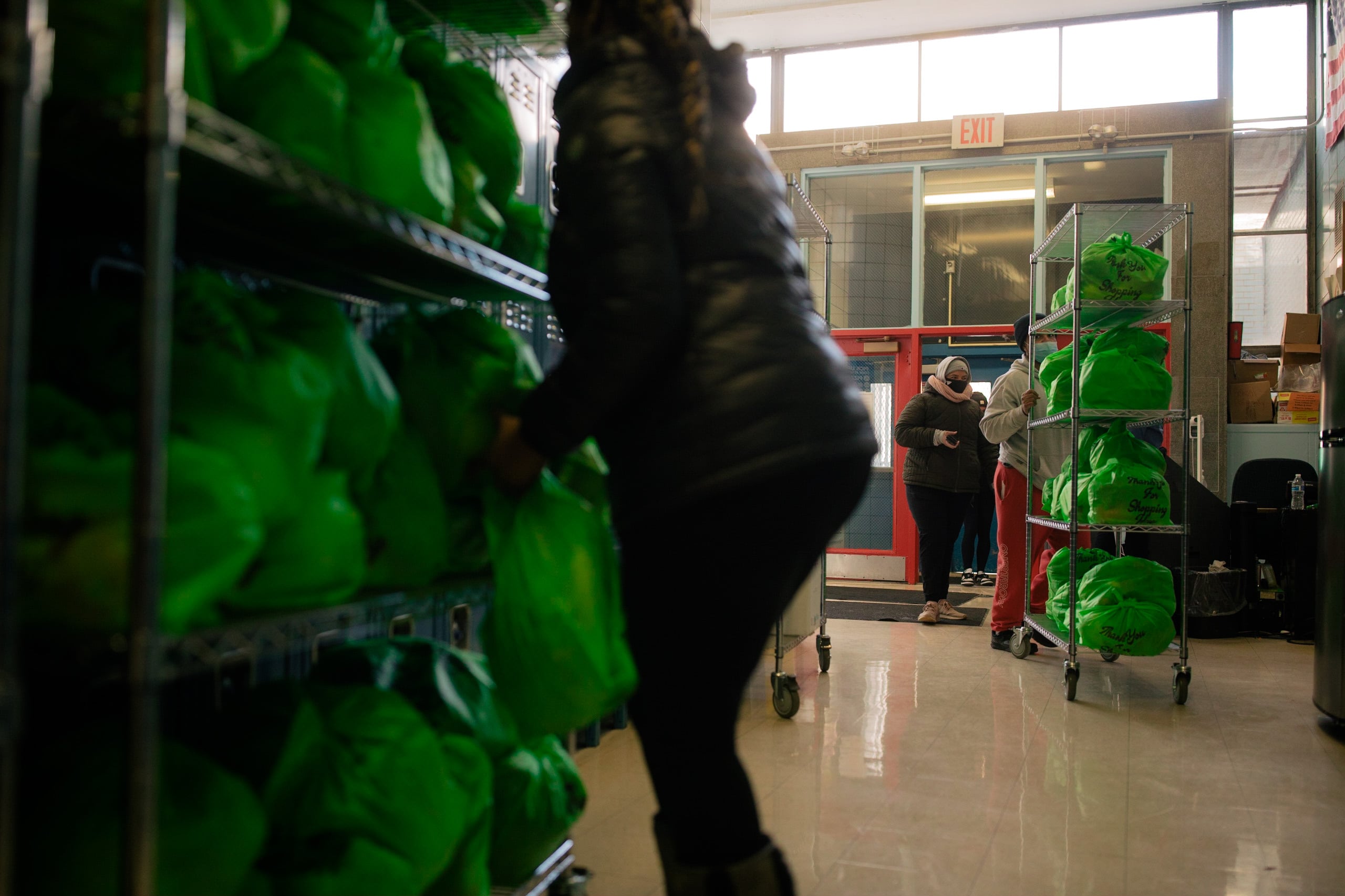Sign up for Chalkbeat New York’s free daily newsletter to get essential news about NYC’s public schools delivered to your inbox.
Twenty umbrellas. Two-dozen cotton pillow cases. Two-dozen hairbrushes. Twenty-eight mens’ long sleeve T-shirts. Thirty boxes of mac & cheese. Fifty-six Oreo snack packs.
These are among the essentials a librarian at a high school in Jamaica, Queens, is raising money to purchase for students in her school’s multicultural club, most of whom are recent immigrants and lack enough money for food, personal care, and weather gear.
Tens of thousands of migrant families and others across the five boroughs are facing intense hardship. Housing insecurity is at a record high for New York City students, with 1 in 8 children experiencing homelessness last year, according to a report for Advocates for Children. Four out of five city families said they found it harder to afford groceries this year, with 41% buying less, or no, protein such as meat, fish, or eggs due to cost, a No Kid Hungry survey from the spring found.
Schools, which have seen an estimated 40,000 migrant students in the last two years, are grappling with how to help families in dire need. But there are understandable constraints and guardrails on how schools can spend their money on these families — meaning teachers and staffers often have to get creative.
Schools can purchase specific items for families with certain pots of money from their budgets, but only from vendors approved by the Education Department, which can make things tricky sometimes. Many would prefer to use school budgets to give gift cards or cash to families, but they can’t under Education Department procurement rules, since administrators couldn’t be sure how the money was spent. And while parent teacher associations are allowed to buy gift cards, they often don’t have much fundraising power. PTAs at about a quarter of schools raised no money at all, according to a 2019 Chalkbeat analysis.
Principals and teachers find ways to fill the gaps. School staffers often tap their own social networks to raise money to purchase food, hygiene items, and other essential items. And many teachers, including the Queens librarian, have turned to online platforms like DonorsChoose to help raise funds for students. In the 2019-20 school year, DonorsChoose saw roughly 970 projects submitted by New York City teachers to cover costs related to students’ warmth, care, and hunger needs, according to data from the nonprofit fundraising platform. This school year so far has already seen nearly 930 such projects.
Some local districts have pooled resources, like East Harlem’s District 4 where the community joined forces with the city’s Project Open Arms to create “care closets,” purchasing or donating clothing, non-perishable food, hygiene products, and more for families.
Rosa Diaz, a parent leader in East Harlem, said the closets provide essential services and will continue to do so, especially as many immigrant families fear what could happen during President-elect Donald Trump’s second term.
Schools with federal Title 1 funding — those with at least 60% of their students from low-income families — have a “homeless set-aside,” according to state rules, which allow schools to buy clothing and shoes “necessary for participation in classes,” personal school supplies such as backpacks, and food, among other expenses.
Under the city’s “Fair Student Funding” guidelines, schools get extra money for students in temporary housing and can use that money “to provide the resources, services, and tools necessary for their success in school.”
“I would love to be able to give gift certificates to families, especially for the money earmarked for [students in temporary housing],” one Manhattan middle school principal said. “Instead we are left surveying families what they need, trying our best to buy what we can through DOE… It would be so much easier to just get gift cards.”
Giving cash would be even better, the principal said.
Elected officials are also figuring out ways to put more money back in New Yorkers’ hands. Gov. Kathy Hochul has proposed an Inflation Refund plan in which someone who is single and earning less than $150,000 per year, would get a check for $300 later next year. Couples filing jointly and earning less than $300,000 annually would get a check for $500. Mayor Eric Adams’ “axe the tax for the working class” plan would eliminate city income taxes for families earning 150% of the federal poverty line or less, and would lower it for families just above. That would affect nearly half a million New Yorkers. City Council recently launched a new version of an initiative providing cash support to 161 pregnant women who are homeless, at risk of losing housing, or facing domestic violence.
Franchesca Chaterpaul, a Brooklyn teacher for 10 years, has seen an increase in need among her students since the pandemic, both for her new arrivals, who came here with no winter gear, and other families as well.
“A lot of families have expressed more than before that it’s been difficult,” said Chaterpaul, who teaches a bilingual class of 12 fourth graders at Bedford-Stuyvesant’s Brighter Choice Community School. (Enrollment at the school has shrunk, she said, as many families have been priced out of the area.)
Families flocked to the school’s food pantry that opened last year (though the partnership ended this year), as well as to the school’s on-site laundry facilities (which are closed this year because of construction).
Chaterpaul is raising money through DonorsChoose to celebrate the winter holidays for her class to help her make gift bags, give out snowflake mini bubble wands, blue lollipops, winter-themed temporary tattoos, hats, gloves, and more.
“My classroom, like Dunkin’, runs on DonorsChoose,” Chaterpaul said.
Amy Zimmer is the bureau chief for Chalkbeat New York. Contact Amy at azimmer@chalkbeat.org.






